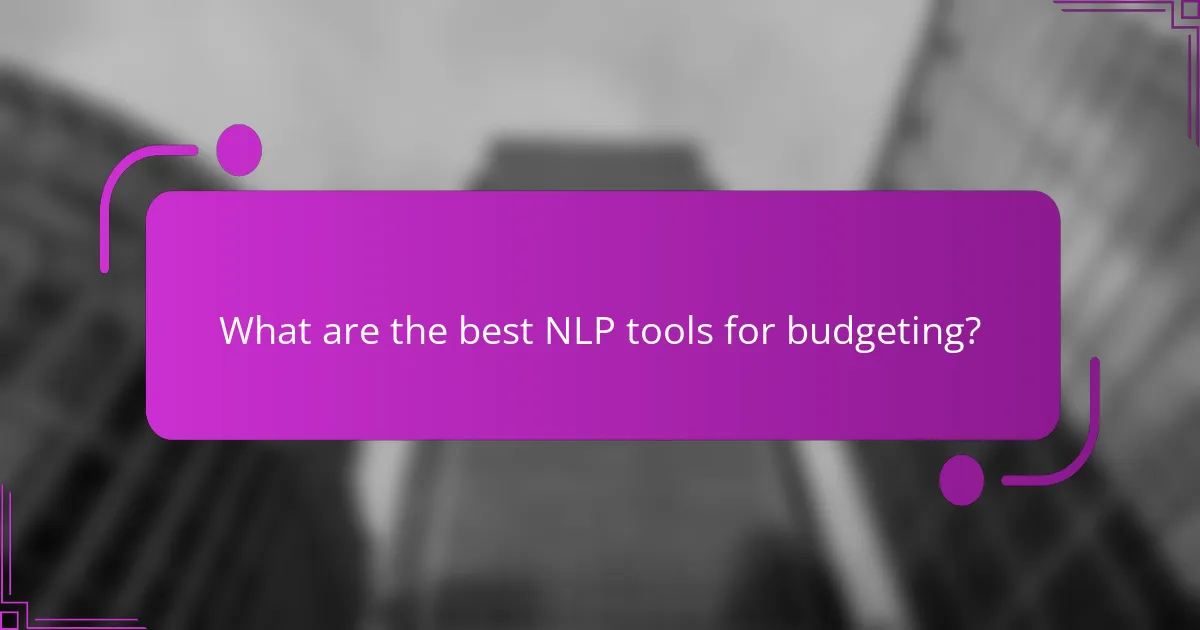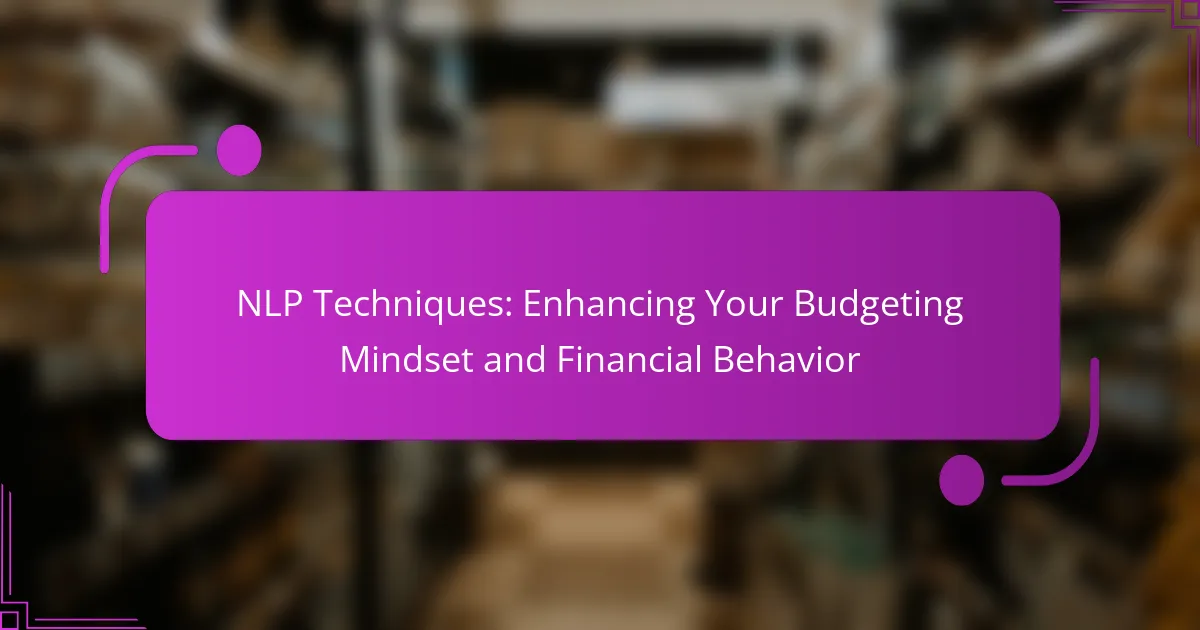NLP techniques offer powerful tools for enhancing your budgeting mindset and improving financial behavior. By utilizing language patterns and psychological insights, these methods can help individuals gain a deeper understanding of their spending habits, leading to more informed financial decisions and healthier budgeting practices.

How can NLP techniques improve budgeting in the United States?
NLP techniques can significantly enhance budgeting by fostering a better understanding of financial behaviors and improving decision-making. By leveraging language patterns and psychological insights, individuals can develop a more effective budgeting mindset, leading to healthier financial habits.
Enhanced financial awareness
Enhanced financial awareness involves recognizing spending habits and understanding financial goals. NLP techniques can help individuals articulate their financial objectives, making them more tangible and achievable. For example, visualizing expenses and savings can clarify where money is going and where adjustments can be made.
Practicing mindfulness in financial decisions can lead to more informed choices. Techniques such as journaling about spending or using affirmations can reinforce positive financial behaviors, helping individuals stay focused on their budgeting goals.
Behavioral pattern recognition
Behavioral pattern recognition allows individuals to identify recurring financial habits that may hinder their budgeting efforts. By analyzing past spending behaviors through NLP methods, one can uncover triggers that lead to impulsive purchases. This awareness can empower individuals to make conscious decisions rather than reactive ones.
For instance, if someone notices they tend to overspend on dining out during stressful weeks, they can proactively plan meals at home or set a specific budget for eating out. Recognizing these patterns is crucial for long-term financial stability.
Automated expense tracking
Automated expense tracking simplifies the budgeting process by using NLP tools to categorize and analyze spending. Many budgeting apps now incorporate NLP to automatically sort transactions, making it easier to see where money is spent without manual entry. This can save time and reduce the likelihood of errors.
Using these tools, individuals can receive alerts when they approach budget limits in specific categories, helping them stay accountable. Regularly reviewing these automated reports can lead to better financial decisions and adjustments as needed.
Personalized budgeting recommendations
Personalized budgeting recommendations leverage NLP to tailor financial advice based on individual spending habits and goals. By analyzing user data, these systems can suggest specific budgeting strategies that align with a person’s financial situation. For example, if someone frequently overspends on entertainment, the system might recommend a lower budget for that category.
Implementing these recommendations can lead to more effective budgeting. Individuals should regularly revisit their budgets and adjust based on the insights provided, ensuring that their financial plans remain relevant and achievable over time.

What are the key NLP techniques for financial behavior?
NLP techniques for financial behavior focus on understanding and improving how individuals manage their finances. These methods leverage language processing to analyze spending patterns, provide personalized advice, and enhance budgeting practices.
Sentiment analysis for spending habits
Sentiment analysis evaluates emotions behind financial decisions by analyzing text data from receipts, bank statements, or personal notes. By identifying positive or negative sentiments associated with spending, individuals can gain insights into their emotional triggers and spending habits.
For example, if someone consistently feels guilty after dining out, they can reconsider their dining budget or frequency. This awareness can lead to more mindful spending and better financial choices.
Chatbots for financial advice
Chatbots utilize NLP to provide real-time financial advice, answering questions about budgeting, saving, and investing. These virtual assistants can analyze user queries and offer tailored recommendations based on individual financial situations.
For instance, a chatbot might suggest adjusting monthly expenses if a user frequently asks about saving for a vacation. This immediate feedback can help users stay on track with their financial goals.
Text analysis for budget reviews
Text analysis involves examining written financial records to identify trends and areas for improvement. By reviewing transaction descriptions and categorizing expenses, individuals can better understand their spending patterns and adjust their budgets accordingly.
A practical approach is to categorize expenses into fixed and variable costs, then analyze which categories consume the most resources. This analysis can highlight unnecessary expenditures and help prioritize savings or investments.

How do NLP tools influence financial decision-making?
NLP tools enhance financial decision-making by improving clarity, reducing biases, and increasing user engagement with budgeting tools. These techniques help individuals better understand their financial behaviors and make more informed choices.
Improved clarity in financial goals
NLP techniques can help individuals articulate their financial goals more clearly. By using specific language patterns and visualization techniques, users can define what they want to achieve—be it saving for a home, retirement, or debt reduction.
For example, instead of vaguely stating “I want to save money,” a clearer goal would be “I want to save $10,000 for a down payment within two years.” This specificity provides a roadmap for action.
Reduction of cognitive biases
NLP tools can assist in identifying and mitigating cognitive biases that often cloud financial judgment. Techniques such as reframing and anchoring can help users recognize their emotional triggers and make more rational decisions.
For instance, someone might have an overconfidence bias regarding their investment choices. By employing NLP strategies, they can reassess their risk tolerance and adjust their investment approach accordingly, potentially avoiding costly mistakes.
Increased engagement with budgeting apps
NLP can enhance user engagement with budgeting applications by personalizing the experience. By analyzing user inputs and behaviors, these tools can provide tailored recommendations that resonate with individual financial situations.
For example, a budgeting app might use NLP to suggest specific spending limits based on past behavior, making it easier for users to stick to their budgets. Regular prompts and reminders can also keep users motivated and accountable.

What are the prerequisites for implementing NLP in budgeting?
To effectively implement NLP in budgeting, you need a foundational understanding of NLP concepts, access to relevant financial data, and the ability to integrate NLP tools with your existing financial systems. These prerequisites ensure that you can leverage NLP techniques to enhance your budgeting mindset and improve financial behavior.
Understanding NLP fundamentals
NLP, or Natural Language Processing, involves the use of algorithms to analyze and interpret human language. Familiarity with basic NLP concepts such as tokenization, sentiment analysis, and entity recognition is essential for applying these techniques to budgeting. Understanding how NLP can extract insights from financial discussions or documents can significantly enhance your budgeting strategies.
Consider starting with online courses or resources that cover NLP basics. This foundational knowledge will help you grasp how to apply these techniques to your financial data effectively.
Access to financial data
Having access to accurate and comprehensive financial data is crucial for implementing NLP in budgeting. This data may include transaction histories, income statements, and expense reports. Ensure that your data is organized and easily retrievable to facilitate effective analysis.
Utilize financial management software that allows for data export in formats compatible with NLP tools. Regularly updating and maintaining your financial records will improve the quality of insights you can derive from NLP applications.
Integration with existing financial tools
Integrating NLP tools with your current financial management systems is vital for a seamless budgeting process. This may involve using APIs or plugins that allow NLP software to communicate with your budgeting applications. Look for tools that offer easy integration options to minimize disruption to your existing workflows.
Evaluate the compatibility of NLP solutions with your current tools, such as spreadsheets or accounting software. This will help you avoid potential pitfalls related to data silos and ensure that insights generated from NLP can be effectively utilized in your budgeting practices.

What are the best NLP tools for budgeting?
The best NLP tools for budgeting help individuals manage their finances more effectively by providing insights and automation. These tools can simplify expense tracking, encourage proactive budgeting, and offer comprehensive financial management solutions.
Mint for expense tracking
Mint is a popular tool for tracking expenses and managing budgets. It automatically syncs with your bank accounts and credit cards, categorizing transactions to give you a clear view of your spending habits. Users can set budget limits for different categories, helping to identify areas where they might overspend.
To get the most out of Mint, regularly review your spending reports and adjust your budgets as needed. Be mindful of potential fees from certain financial institutions when linking accounts, and ensure you understand how Mint categorizes your transactions to maintain accurate tracking.
YNAB for proactive budgeting
You Need A Budget (YNAB) is designed to promote proactive financial management by encouraging users to allocate every dollar they earn. This method helps users prioritize their spending and savings goals, making it easier to avoid debt and build wealth over time. YNAB offers educational resources to help users develop better budgeting habits.
To effectively use YNAB, start by setting clear financial goals and regularly updating your budget based on your income and expenses. Take advantage of YNAB’s mobile app for on-the-go tracking, and remember to review your budget weekly to stay on track. Avoid the common pitfall of neglecting to adjust your budget as your financial situation changes.
Quicken for comprehensive financial management
Quicken provides a robust suite of tools for comprehensive financial management, including budgeting, investment tracking, and bill payment. It allows users to view all their financial accounts in one place, making it easier to manage cash flow and plan for future expenses. Quicken is particularly beneficial for users with complex financial situations.
To maximize Quicken’s potential, take the time to set up your accounts accurately and categorize your transactions effectively. Utilize its reporting features to gain insights into your financial health and adjust your strategies accordingly. Be aware of the subscription costs associated with Quicken, which can vary based on the features you choose to use.



